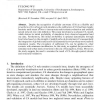Free Online Productivity Tools
i2Speak
i2Symbol
i2OCR
iTex2Img
iWeb2Print
iWeb2Shot
i2Type
iPdf2Split
iPdf2Merge
i2Bopomofo
i2Arabic
i2Style
i2Image
i2PDF
iLatex2Rtf
Sci2ools
119
Voted
GIS
2002
ACM
2002
ACM
Calibration of stochastic cellular automata: the application to rural-urban land conversions
Despite the recognition of cellular automata (CA) as a exible and powerful tool for urban growth simulation, the calibration of CA had been largely heuristic until recent eVorts to incorporate multi-criteria evaluation and arti cial neural network into rule de nition. This study developed a stochastic CA model, which derives its initial probability of simulation from observed sequential land use data. Furthermore, this initial probability is updated dynamically through local rules based on the strength of neighbourhood development. Consequentially the integration of global (static) and local (dynamic) factors produces more realistic simulation results. The procedure of calibrated CA can be applied in other contexts with minimum modi cation. In this study we applied the procedure to simulate rural-urban land conversions in the city of Guangzhou, China. Moreover, the study suggests the need to examine the result of CA through spatial, tabular and structural validation.
Automated Reasoning | GIS 2002 | Initial Probability | Stochastic Ca Model | Urban Growth Simulation |
| Added | 19 Dec 2010 |
| Updated | 19 Dec 2010 |
| Type | Journal |
| Year | 2002 |
| Where | GIS |
| Authors | Fulong Wu |
Comments (0)

